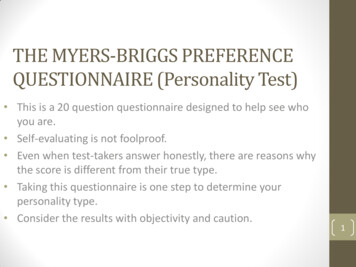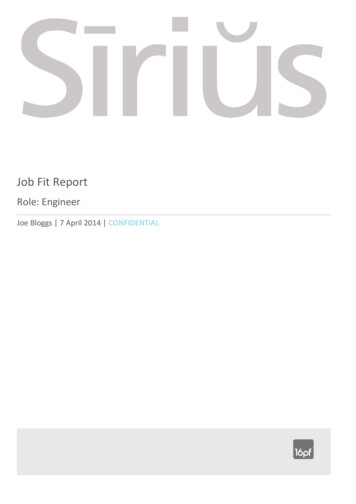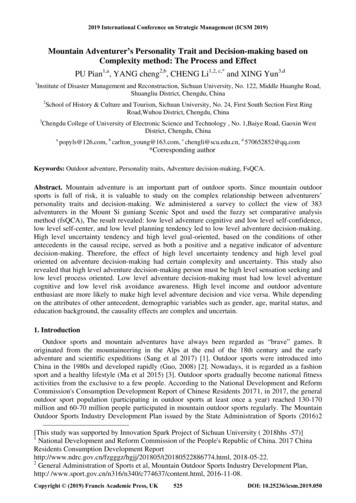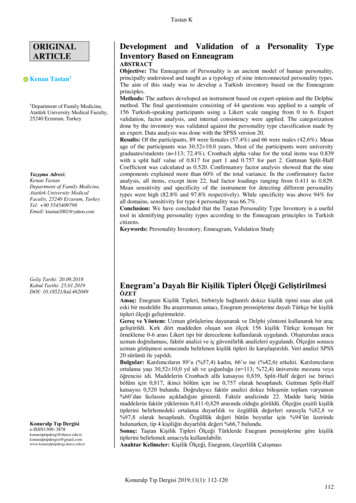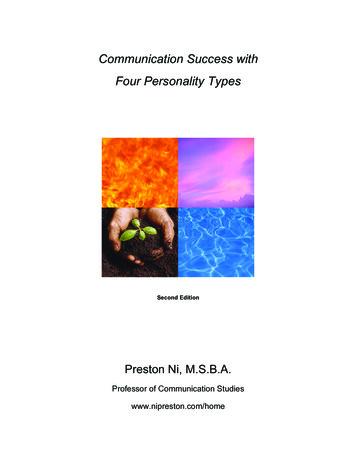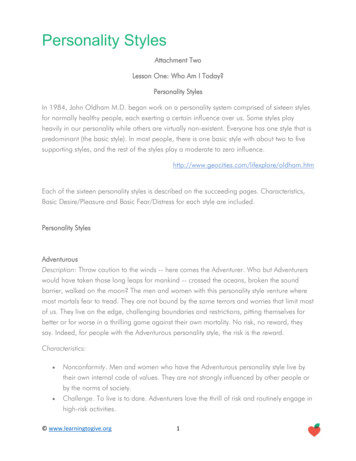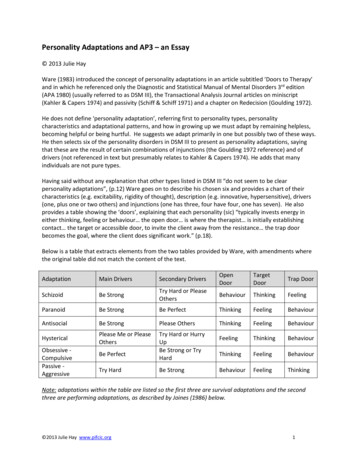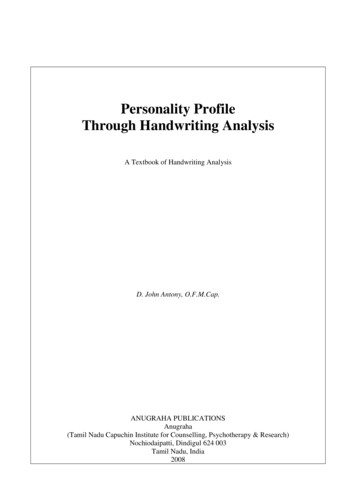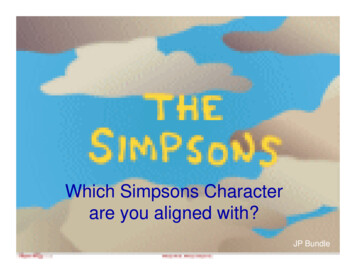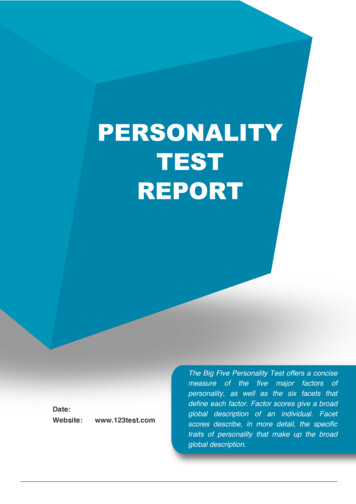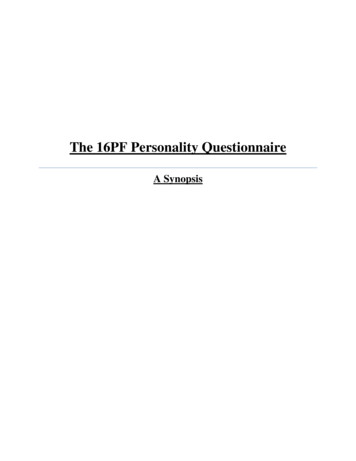
Transcription
The 16PF Personality QuestionnaireA Synopsis
Synopsis of 16PF QuestionnaireFrom: Dilshad Edibam, Roll No. 8For: Ms. Anuja DeshpandeIntroductionThe Sixteen Personality Factor Questionnaire (or 16PF), is a self-report, multiplechoice personality questionnaire which was developed over several decades of researchby Raymond B. Cattell, Maurice Tatsuoka and Herbert Eber. Beginning in the 1940s, Cattellused the new techniques of factor analysis (based on the correlation coefficient) in an attempt totry to discover and measure the fundamental traits of human personality (Cattell, 1946).Using client responses to the questionnaire, standardized scores (stens) are derived for each ofthe sixteen personality factors. In addition, scores for five Global Factors (the original FiveFactor Model) are computed. These scores enable clients to formulate personality models usefulin industrial/organizational applications, clinical settings, counseling, and research for predictinghuman behavior.Factor analysis is a statistical method used to describe variability among observed, correlatedvariables in terms of a potentially lower number of unobserved, uncorrelated variablescalled factors. In other words, it is possible, for example, that variations in three or fourobserved variables mainly reflect the variations in fewer such unobserved variables.About the authorThat the 16PF Questionnaire originated from scientific inquiry was no accident; its author,Raymond B. Cattell, was the product of a strong scientific and analytical background. Hisgrandfather, father, and brother were inventors and engineers.At that time, the field of scientific psychology was quite limited in scope. Cattell studied thework of physiological and experimental psychologists (e.g., Pavlov, Thorndike, and Wundt) whoused the scientific method to examine very particular areas of human functioning such assensation and learning.Cattell was influenced by his studies and by the social and political ferment of post-World War ILondon. This experience led Cattell to believe that the biggest problems in the world were oftenthe result of human temperament and motivation. He speculated that there must be some way toapply the powerful tools of science to understanding human personality.Thus, Cattell's goal in creating the 16PF Questionnaire was to provide a thorough, researchbased map of normal personality. Cattell believed in examining the broadest possible range ofpersonality phenomena, including roles and states, thoughts and actions, verbal and nonverbalbehavior, normal and abnormal personality, and ability and interest variables. He believed thatfor psychology to advance as a science, psychologists needed scientific measurement proceduresfor three distinct domains of human characteristics: personality, ability, and motivation (with thelatter defined as dynamic drives such as a need for power, achievement, or security). Bysampling each of these domains and applying factor-analytic methods, Cattell sought to discoverthe number and nature of the variables that comprised the meaning of each.2
Synopsis of 16PF QuestionnaireFrom: Dilshad Edibam, Roll No. 8For: Ms. Anuja DeshpandeHistory of the 16PF Questionnaire1930sCattell works with Charles Spearman in the development of factor-analytic methods to study thestructure of human abilities.1940sCattell begins comprehensive programme of research, applying factor analysis to identify thebasic elements of personality structure.1949 - The 16PF Questionnaire, 1st Edition is released in the United States.1950s1952 – The 16PF Questionnaire, 1st Edition is released in Great Britian1953 – First publication of the High School Personality Questionnaire (HSPQ)1956 - 16PF 2nd Edition is released.1959 - First publication of the Children‟s Personality Questionnaire (CPQ)1960s1962 - 16PF 3rd Edition is released.1963 - Early School Personality Questionnaire (ESPQ) is released for use in educational,counseling, and developmental settings, completing the personality assessment series spanningthe entire age range: Early School Personality Questionnaire (ESPQ) for ages 6-8, Children'sPersonality Questionnaire (CPQ) for ages 8 to 12, High School Personality Questionnaire(HSPQ) for ages 12 to 18, and 16PF Questionnaire for ages 16 and above.1965 – Introduction of computer scoring by mail1968 - 16PF 4th Edition is released.1970s1972 – Publication of the first computerized interpretive report3
Synopsis of 16PF QuestionnaireFrom: Dilshad Edibam, Roll No. 8For: Ms. Anuja Deshpande1980s1980 – Test translation exceed 35 languages worldwide1990s1992 – Computer scoring by OnSite Software1993 - 16PF 5th Edition is released, which includes a combination of the forms, streamlinedadministration, modernization of the content, and a major normative update.1997 - American Psychological Association and the American Psychological Foundationnominate Cattell for the Gold Medal for Lifetime Achievement, an accolade awarded only 12times before.1998 - Raymond Cattell passes away at the age of 92 in Hawaii.1999 – Online administration and scoring, and computerized interpretive reports (NetAssess)were introduced.1999 – Publication of the 16PF Select Questionnaire2000s2000 – Re-standardization of the 16PF Fifth edition with over 10,000 people.2001 – Online administration and scoring, and computerized interpretive reports becameavailable in multiple international languages2001 – Publication of the 16PF Adolescent Personality Questionnaire (APQ, a version of HSPQ)4
Synopsis of 16PF QuestionnaireFrom: Dilshad Edibam, Roll No. 8For: Ms. Anuja DeshpandeDescription of 16 PFThe 16PF Questionnaire measures these 16 normal adult personality dimensions discovered byDr. Cattell in his landmark research WarmthReasoningEmotional StabilityDominanceLivelinessRule-Consciousness Social essApprehensiveness Openness to ChangeSelf-ReliancePerfectionismTensionThe 16PF model is hierarchical. When the 16 primary traits were factor-analyzed, they revealedfive Global Factors, which describe personality at a broader level. These Global Factors, whichhelp to show the degree of relationships among the 16 primary scales, are: f-Control* Type of Test: It is a non-verbal test of personality which can be administered individually or asa group test.* Age range: 16 years upwards, however, it must be noted that this test has several variations,designed for younger age groups. These are :1) The High School Personality Questionnaire [Cattell and Cattell, 1969] – 12 to 15 years.2) The Childs Personality Questionnaire [Porter and Cattell, 1936] – 8 to 11 years.3) The Early School Personality Questionnaire [Coan and Cattell, 1966] – 6 to 7 years.4) The Pre-school Personality Questionnaire [Cattell, 1957] – 4 to 6 years.* Forms available are A, B, C and D. The primary difference between Forms A and B on onehand, and Forms C and D on the other, is in their length, (Forms C and D being shorter) andtherefore, the time required for their administration. A separate Form E is designed forindividuals with marked educational and/or reading deficits.*In Forms A and B, ten to thirteen items are provided for each scale. In Forms C and D, thereare eight items for Factor B, seven items for the motivational distortion scale, and six items eachfor the remaining factors.5
Synopsis of 16PF QuestionnaireFrom: Dilshad Edibam, Roll No. 8For: Ms. Anuja Deshpande*Three alternative answers are provided for each of the questions, with the second one being a„middle-of-the-road‟ compromise option. In Form E, a two-choice design is used.*Questionnaires are often, justifiably, considered susceptible to distortion and deliberate faking.Forms C and D contain a single motivational distortion (MD) scale to find out whether the testtaker has given fake or socially desirable responses.Administration of the test*Simple and clear instructions are printed for the examinee on the cover page of the test booklet.Although the test can be virtually self-administered, it is always important to establish goodrapport with the examinees, whether tested individually or in groups.*Answers should always be made on a separate answer sheet, never in the reusable test booklet.Two types of answer sheets are available – machine or hand scorable.*Begin by having examinee provide name, age, sex, and address in the appropriate spacesprovided in the answer sheet.*The examinee should then read the instructions on the cover of the test booklet and respond tothe examples in the appropriate area on the answer sheet. It may be desirable to read theinstructions aloud with the client or to discuss certain points. The examiner must be the judge ofthe best way to get across the instruction to the examinees. About five minutes should beallowed for reading the instructions and working the examples. Then say, “Turn the page andbegin.”* The test is untimed, but it is good to remind examinees that they should not dally, but shouldgive immediate answers and move along. Normal completion time is 35 – 45 minutes.6
Synopsis of 16PF QuestionnaireFrom: Dilshad Edibam, Roll No. 8For: Ms. Anuja DeshpandeScoringThe 16PF can be either computer scored or hand scored with a set of scoring stencils.Regardless of which method is used, each answer sheet should be checked to make sure thatthere are no odd, unscorable responses, eg, marking more than one alternative, makingincomplete erasures, or entirely omitting a response to an item.Each answer scores 0, 1, or 2 points, except Factor B (conceptual ability) answers, which score 0(incorrect) or 1 (correct). Detailed instructions for obtaining raw scores are provided on thescoring keys. Scoring begins by fitting and aligning the first stencil key over the answer sheetand counting the marks visible through the holes for Factor A, allowing either 2 or 1, asindicated by the number adjacent to the hole.Sum these scores and enter the total in the space indicated by the arrow on the stencil for FactorA (raw score). Factor B (intelligence) is peculiar in that each correct mark visible in a hole givesa score of 1 only. Continue scoring each factor on each scoring key until all raw scores havebeen entered in the column on the extreme right of the answer sheet.The raw scores are now ready to be converted to standard scores (sten scores) and the resultsprofiled for easier review and interpretation. Selection of the most appropriate norm group isbased on age of the examinee or current membership in the specific norm group. Within eachgroup, tables are available for men, women, and men and women together. To convert the rawscores to stens, one finds the raw score for Factor A in the „A‟ line and reads the correspondingsten score above it. One then proceeds likewise for the other factors.The sten score for Factor MD (Motivational Distortion) was obtained from the Norms booklet,using the MD scale.The obtained sten scores are then plotted on the 16PF Test Profile sheet, for each factor Sten scores of 1 – 4 come under the low score categorySten scores of 5 and 6 come under the average score categorySten scores of 7 – 10 come under the high score category7
Synopsis of 16PF QuestionnaireFrom: Dilshad Edibam, Roll No. 8For: Ms. Anuja DeshpandeInterpretation of ResultsPlotting the sten scores for each factor tells us whether the subject is in the low score/averagescore/high score category for each factor. Based on this categorization, the correspondingdescriptions for each factor are found by consulting the Administrator‟s Manual.Descriptors of Low RangePrimaryFactorDescriptors of High RangeImpersonal, distant, cool, reserved,detached, formal, aloofWarmth(A)Warm, outgoing, attentive toothers, kindly, easy-going,participating, likes peopleConcrete thinking, lower general mentalcapacity, less intelligent, unable to handleabstract problemsReasoning(B)Abstract-thinking, more intelligent,bright, higher general mentalcapacity, fast learnerReactive emotionally, changeable, affectedby feelings, emotionally less stable, easilyupsetEmotionalStability(C)Emotionally stable, adaptive,mature, faces reality calmlyDeferential, cooperative, avoids conflict,submissive, humble, obedient, easily led,docile, accommodatingDominance(E)Dominant, forceful, assertive,aggressive, competitive, stubborn,bossySerious, restrained, prudent, taciturn,introspective, silentLiveliness(F)Lively, animated, spontaneous,enthusiastic, happy go lucky,cheerful, expressive, impulsiveExpedient, nonconforming, disregardsrules, self indulgentRuleConsciousness(G)Rule-conscious, dutiful,conscientious, conforming,moralistic, staid, rule boundShy, threat-sensitive, timid, hesitant,intimidatedSocial Boldness Socially bold, venturesome, thick(H)skinned, uninhibited8
Synopsis of 16PF QuestionnaireFrom: Dilshad Edibam, Roll No. 8For: Ms. Anuja DeshpandeUtilitarian, objective, unsentimental, toughminded, self-reliant, no-nonsense, roughSensitivity(I)Sensitive, aesthetic, sentimental,tender minded, intuitive, refinedTrusting, unsuspecting, accepting,unconditional, easyVigilance(L)Vigilant, suspicious, skeptical,distrustful, oppositionalGrounded, practical, prosaic, solutionoriented, steady, conventionalAbstractedness(M)Abstract, imaginative, absentminded, impractical, absorbed inideasForthright, genuine, artless, open,guileless, naive, unpretentious, involvedPrivateness(N)Private, discreet, non-disclosing,shrewd, polished, worldly, astute,diplomaticSelf-Assured, unworried, complacent,secure, free of guilt, confident, selfsatisfiedApprehension(O)Apprehensive, self doubting,worried, guilt prone, insecure,worrying, self blamingTraditional, attached to familiar,conservative, respecting traditional ideasOpenness toChange(Q1)Open to change, experimental,liberal, analytical, critical, freethinking, flexibilityGroup-oriented, affiliative, a joiner andfollower dependentSelf-Reliance(Q2)Self-reliant, solit
Personality Questionnaire (CPQ) for ages 8 to 12, High School Personality Questionnaire (HSPQ) for ages 12 to 18, and 16PF Questionnaire for ages 16 and above. 1965 – Introduction of computer scoring by mail 1968 - 16PF 4th Edition is released. 1970s 1972 – Publication of the first computerized interpretive report . Synopsis of 16PF Questionnaire From: Dilshad Edibam, Roll No. 8 For: Ms .
